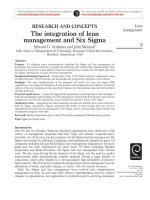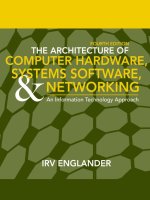The architecture of computer hardware and systems software an information technology approach ch03 1
Bạn đang xem bản rút gọn của tài liệu. Xem và tải ngay bản đầy đủ của tài liệu tại đây (264.33 KB, 39 trang )
CHAPTER 3:
Data Formats
The Architecture of Computer Hardware
and Systems Software:
An Information Technology Approach
3rd Edition, Irv Englander
John Wiley and Sons 2003
Data Formats
Computers
Process and store all forms of data in binary
format
Human communication
Includes language, images and sounds
Data formats:
Specifications for converting data into computerusable form
Define the different ways human data may be
represented, stored and processed by a computer
Chapter 3 Data Formats
3-2
Sources of Data
Binary input
Begins as discrete input
Example: keyboard input such as A 1+2=3 math
Keyboard generates a binary number code for each key
Analog
Continuous data such as sound or images
Requires hardware to convert data into binary numbers
Figure 3.1 with this
color scheme
A 1+2=3 math
Computer
Input
device
1101000101010101…
Chapter 3 Data Formats
3-3
Common Data Representations
Type of Data
Standard(s)
Alphanumeric
Unicode, ASCII, EDCDIC
Image (bitmapped)
GIF (graphical image format)
TIF (tagged image file format)
PNG (portable network graphics)
Image (object)
PostScript, JPEG, SWF (Macromedia
Flash), SVG
Outline graphics and fonts PostScript, TrueType
Sound
WAV, AVI, MP3, MIDI, WMA
Page description
PDF (Adobe Portable Document
Format), HTML, XML
Video
Quicktime, MPEG-2, RealVideo, WMV
Chapter 3 Data Formats
3-4
Internal Data Representation
Reflects the
Complexity of input source
Type of processing required
Trade-offs
Accuracy and resolution
Simple photo vs. painting in an art book
Compactness (storage and transmission)
More data required for improved accuracy and resolution
Compression represents data in a more compact form
Metadata: data that describes or interprets the meaning of data
Ease of manipulation:
Processing simple audio vs. high-fidelity sound
Standardization
Proprietary formats for storing and processing data (WordPerfect vs.
Word)
De facto standards: proprietary standards based on general user
acceptance (PostScript)
Chapter 3 Data Formats
3-5
Data Types: Alphanumeric
Alphanumeric:
Characters: b T
Number digits: 7 9
Punctuation marks: ! ;
Special-purpose characters: $ &
Numeric characters vs. numbers
Both entered as ordinary characters
Computer converts into numbers for calculation
Examples: Variables declared as numbers by the
programmer (Salary$ in BASIC)
Treated as characters if processed as text
Examples: Phone numbers, ZIP codes
Chapter 3 Data Formats
3-6
Alphanumeric Codes
Arbitrary choice of bits to represent characters
Consistency: input and output device must
recognize same code
Value of binary number representing character
corresponds to placement in the alphabet
Facilitates sorting and searching
Chapter 3 Data Formats
3-7
Representing Characters
ASCII - most widely used coding scheme
EBCDIC: IBM mainframe (legacy)
Unicode: developed for worldwide use
Chapter 3 Data Formats
3-8
ASCII
Developed by ANSI (American National Standards
Institute)
Represents
Latin alphabet, Arabic numerals, standard
punctuation characters
Plus small set of accents and other European
special characters
ASCII
7-bit code: 128 characters
Chapter 3 Data Formats
3-9
ASCII Reference Table
MSD
LSD
0
1
2
3
4
5
0
NUL
DLE
SP
0
@
P
1
SOH
DC1
!
1
A
Q
a
W
2
STX
DC2
“
2
B
R
b
r
3
ETX
DC3
#
3
C
S
c
s
4
EOT
DC4
$
4
D
T
d
t
5
ENQ
NAK
%
5
E
U
e
u
6
ACJ
SYN
&
6
F
V
f
v
7
BEL
ETB
‘
7
G
W
g
w
8
BS
CAN
(
8
H
X
h
x
9
HT
EM
)
9
I
Y
i
y
A
LF
SUB
*
:
J
Z
j
z
B
VT
ESC
+
;
K
[
k
{
C
FF
FS
,
<
L
\
l
|
D
CR
GS
-
=
M
]
m
}
E
SO
RS
.
>
N
^
n
~
F
SI
US
/
?
O
_
o
DEL
Chapter 3 Data Formats
6
7
p
7416
111 0100
3-10
EBCDIC
Extended Binary Coded Decimal Interchange
Code developed by IBM
Restricted mainly to IBM or IBM compatible
mainframes
Conversion software to/from ASCII available
Common in archival data
Character codes differ from ASCII
ASCII
EBCDIC
Space
2016
4016
A
4116
C116
b
6216
8216
Chapter 3 Data Formats
3-11
Unicode
Most common 16-bit form represents 65,536
characters
ASCII Latin-I subset of Unicode
Values 0 to 255 in Unicode table
Multilingual: defines codes for
Nearly every character-based alphabet
Large set of ideographs for Chinese, Japanese
and Korean
Composite characters for vowels and syllabic
clusters required by some languages
Allows software modifications for locallanguages
Chapter 3 Data Formats
3-12
Collating Sequence
Alphabetic sorting if software handles mixed
upper- and lowercase codes
In ASCII, numbers collate first; in EBCDIC,
last
ASCII collating sequence for string of
characters
Letters
Numeric Characters
Adam
A d a m
Adamian
A d a m i a n
Adams
A d a m s
Chapter
3 Data Formats
1 011
000
1
12 011
000
1
2 011
001
0
011
001
0
3-13
2 Classes of Codes
Printing characters
Produced on the screen or printer
Control characters
Control position of output on screen or printer
VT: vertical tab
LF: Line feed
Cause action to occur
BEL: bell rings
DEL: delete current character
Communicate status between computer and I/O
device
ESC: provides extensions by changing the meaning of a
specified number of contiguous following characters
Chapter 3 Data Formats
3-14
Keyboard Input
Scan code
Two different scan codes on keyboard
One generated when key is struck and another when key
is released
Converted to Unicode, ASCII or EBCDIC by
software in terminal or PC
Advantage
Easily adapted to different languages or keyboard
layout
Separate scan codes for key press/release for
multiple key combinations
Examples: shift and control keys
Chapter 3 Data Formats
3-15
Other Alphanumeric Input
OCR (optical character reader)
Scans text and inputs it as character data
Used to read specially encoded characters
Example: magnetically printed check numbers
General use limited by high error rate
Bar Code Readers
Used in applications that require fast, accurate and repetitive input
with minimal employee training
Examples: supermarket checkout counters and inventory control
Alphanumeric data in bar code read optically using wand
Magnetic stripe reader: alphanumeric data from credit cards
Voice
Digitized audio recording common but conversion to alphanumeric
data difficult
Requires knowledge of sound patterns in a language (phonemes) plus
rules for pronunciation, grammar, and syntax
Chapter 3 Data Formats
3-16
Image Data
Photographs, figures, icons, drawings, charts and
graphs
Two approaches:
Bitmap or raster images of photos and paintings with
continuous variation
Object or vector images composed of graphical objects like
lines and curves defined geometrically
Differences include:
Quality of the image
Storage space required
Time to transmit
Ease of modification
Specifications for graphics file formats
The Graphics File Format Page
Chapter 3 Data Formats
3-17
Bitmap Images
Used for realistic images with continuous variations in
shading, color, shape and texture
Examples:
Scanned photos
Clip art generated by a paint program
Preferred when image contains large amount of detail
and processing requirements are fairly simple
Input devices:
Scanners
Digital cameras and video capture devices
Graphical input devices like mice and pens
Managed by photo editing software or paint software
Editing tools to make tedious bit by bit process easier
Chapter 3 Data Formats
3-18
Bitmap Images
Each individual pixel (pi(x)cture element) in a
graphic stored as a binary number
Pixel: A small area with associated coordinate
location
Example: each point below represented by a 4-bit
code corresponding to 1 of 16 shades of gray
Chapter 3 Data Formats
3-19
Bitmap Display
Monochrome: black or white
1 bit per pixel
Gray scale: black, white or 254 shades of gray
1 byte per pixel
Color graphics: 16 colors, 256 colors, or 24-bit true
color (16.7 million colors)
4, 8, and 24 bits respectively
Chapter 3 Data Formats
3-20
Storing Bitmap Images
Frequently large files
Example: 600 rows of 800 pixels with 1 byte for
each of 3 colors
~1.5MB file
File size affected by
Resolution (the number of pixels per inch)
Amount of detail affecting clarity and sharpness of an
image
Levels: number of bits for displaying shades of
gray or multiple colors
Palette: color translation table that uses a code for each
pixel rather than actual color value
Data compression
Chapter 3 Data Formats
3-21
GIF (Graphics Interchange Format)
First developed by CompuServe in 1987
GIF89a enabled animated images
allows images to be displayed sequentially at fixed
time sequences
Color limitation: 256
Image compressed by LZW (Lempel-ZifWelch) algorithm
Preferred for line drawings, clip art and
pictures with large blocks of solid color
Lossless compression
Chapter 3 Data Formats
3-22
JPEG
(Joint Photographers Expert Group)
Allows more than 16 million colors
Suitable for highly detailed photographs and paintings
Employs lossy compression algorithm that
Discards data to decreases file size and
transmission speed
May reduce image resolution, tends to distort
sharp lines
Chapter 3 Data Formats
3-23
Other Bitmap Formats
TIFF (Tagged Image File Format): .tif (pronounced tif)
Used in high-quality image processing, particularly in
publishing
BMP (BitMaPped): .bmp (pronounced dot bmp)
Device-independent format for Microsoft Windows
environment: pixel colors stored independent of output device
PCX: .pcx (pronounced dot p c x)
Windows Paintbrush software
PNG: (Portable Network Graphics): .png (pronounced
ping)
Designed to replace GIF and JPEG for Internet applications
Patent-free
Improved lossless compression
No animation support
Chapter 3 Data Formats
3-24
Object Images
Created by drawing packages or output from
spreadsheet data graphs
Composed of lines and shapes in various
colors
Computer translates geometric formulas to
create the graphic
Storage space depends on image complexity
number of instructions to create lines, shapes, fill
patterns
Movies Shrek and Toy Story use object
images
Chapter 3 Data Formats
3-25









